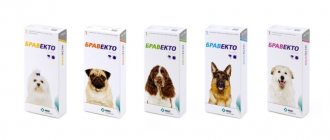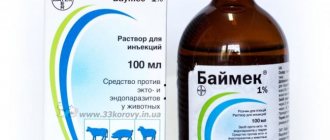Pharmacological properties of the drug "Forticarb" for dogs
Forticarb is active against Babesia, Franciella and Anaplasma
in domestic animals, as well as Ehrlichia canis in dogs.
When administered subcutaneously or intramuscularly, forticarb is quickly absorbed and penetrates into the tissues and organs of the animal's body. Forticarb is practically not metabolized in the animal's body and is excreted unchanged.
Forticarb is sometimes used to treat ehrlichiosis in dogs, hepatozoonosis in dogs, cytozoonosis in cats, and babesiosis in cats. The active substance of forticarb is imidocarb dipropionate. When imidocarb dipropionate is prescribed to treat ehrlichiosis in dogs, hepatozoonosis in dogs, cytazoonosis in cats and babesiosis, this is called off-label treatment. Many drugs are commonly prescribed for off-label uses in veterinary medicine. In these cases, follow your veterinarian's directions and warnings very carefully, as their directions may differ significantly from those on the label.
Composition of the drug
The drug contains only one active ingredient. This is imidocarb dipropionate. It is a powerful remedy against many pathogens of blood parasitic diseases. The substance acts on the pathogens of piroplasmosis, nuttalliosis, and babesiosis. The mechanism of action is to stop the synthesis of polyamines in the body of parasites.
The advantage of imidocarb is its ability to maintain therapeutic concentrations in the animal’s blood for a long time: after one administration, the drug remains in the plasma for up to three weeks.
But another property of it is even more important - it is practically not metabolized, and therefore its toxic effect on the dog’s body is very insignificant. The following are used as auxiliary components:
- Benzyl alcohol.
- Propionic acid.
- Polyvinylpyrrolidone.
- Water for injection is used as a “filler”.
Instructions, doses and method of use of forticarb in dogs and cats
According to the instructions for use of the drug, forticarb is administered to dogs with piroplasmosis once subcutaneously or intramuscularly at a dose of 4.0 mg/kg of animal body weight. 1 ml of forticarb 5% contains 5 mg of imidocarb (doses are given in Table 1). In the case of a control examination of blood smears one day after the administration of a 5% Forticarb solution and detection of piroplasms in them, the drug is re-administered in a standard dose.
Table 1 - Doses of forticarb 5% in dogs
27 70
| Weight | Drug dose 5%, ml | Weight | Drug dose 5%, ml | Weight | Drug dose 5%, ml |
| 1 | 0,08 | 11 | 0,88 | 30 | 2,4 |
| 2 | 0,16 | 12 | 0,96 | 32 | 2,56 |
| 3 | 0,24 | 13 | 1,04 | 35 | 2,8 |
| 4 | 0,32 | 14 | 1,12 | 37 | 2,96 |
| 5 | 0,4 | 15 | 1,2 | 40 | 3,2 |
| 6 | 0,48 | 17,5 | 1,4 | 45 | 3,6 |
| 7 | 0,56 | 20 | 1,6 | 50 | 4 |
| 8 | 0,64 | 22 | 1,76 | 55 | 4,4 |
| 9 | 0,72 | 25 | 2 | 60 | 4,8 |
| 10 | 0,8 | 27 | 2,16 | 70 | 5,6 |
Contraindications
Since the drug belongs to list “B”, there are contraindications for its use:
- It should not be prescribed to young pets (less than two months old), as well as to old dogs and other pets whose bodies are weakened. This also applies to animals that have recently suffered from something really serious.
- The drug should not be administered to animals even with suspected renal or liver failure.
- The medicine should be used with caution to treat dogs with problems with the cardiovascular system.
- It is not recommended to administer it to dogs that have a pronounced predisposition to the development of allergic reactions. If such a need arises, this must be done under the constant supervision of a veterinarian.
And most importantly, the simultaneous use of the drug with organochlorine and organophosphorus drugs is strictly prohibited. Their incompatibility is so serious that violating this rule can result in the death of the pet.
The most popular and effective drug, used for a long time to combat piroplasmosis in dogs, is Forticarb.
Most dog owners know that this pathology poses a mortal threat to their pets. According to statistics, more than 90% of infected pets die.
Use of forticarb in cats
According to a study (Lappin MR et al, 2019), imidocarb dipropionate was administered twice at a dose of 5.0 mg/kg by intramuscular injection at an interval of 14 days to eight cats with chronic subclinical hemobartonellosis. No side effects or toxicity have been established. The dosages of the drug are indicated in Table 2.
Table 2 - Forticarb dosages for cats
| Weight | Drug dose 5%, ml |
| 0,5 | 0,05 |
| 1 | 0,1 |
| 1,5 | 0,15 |
| 2 | 0,2 |
| 2,5 | 0,25 |
| 3 | 0,3 |
| 3,5 | 0,35 |
| 4 | 0,4 |
| 4,5 | 0,45 |
| 5 | 0,5 |
| 5,5 | 0,55 |
| 6 | 0,6 |
| 6,5 | 0,65 |
| 7 | 0,7 |
| 7,5 | 0,75 |
| 8 | 0,8 |
According to the instructions for use of the drug, it is possible to use forticarb in dogs and cats for prophylactic purposes, in case of attack (or risk of attack) by ticks. Forticarb is administered once subcutaneously or intramuscularly at a dose of 4.0 mg/kg of animal body weight. The protective effect is observed within 10-14 days.
Indications for use
In veterinary practice, the indications for use of the drug are as follows:
- Treatment and prevention of babesiosis (piroplasmosis).
- To destroy Franciella (not relevant in the case of dogs, this parasite does not take root in them).
- With anaplasmosis.
- For the treatment of ehrlichiosis.
An objective indication for use is always a massive attack of blood-sucking ixodid ticks. Simply put, if after a walk in the forest or park the dog has a dozen parasites attached to it, the drug will definitely not be superfluous.
Remember! According to WHO statistics, at least 30-39% of all “domestic” ticks are infected with blood parasites, and therefore among the sucking arthropods there will most likely be sick individuals.
Within three hours after injection, imidocarb is already in most cells and tissues of the body. As noted above, this substance practically does not change in the liver and kidneys, which prevents the formation of toxic compounds and preserves the health of dogs even with long-term use of the drug.
Are there potential side effects?
Dogs:
The most common side effects in dogs include pain during injection, drooling or drooling, clear fluid coming from the nasal cavity, and brief episodes of vomiting. Less common side effects include shortness of breath, diarrhea, swelling at the injection site, and restlessness. Rarely, a wound may form at the injection site.
Cats:
The most commonly observed side effects in cats are drooling/drooling, lacrimation, vomiting, diarrhea, muscle tremors, restlessness, rapid heart rate, and difficulty breathing.
If side effects of drooling or nasal discharge are severe, contact your veterinarian.
Contraindications and side effects
According to the manufacturer of the drug, the use of Forticarb for preventive and therapeutic purposes does not cause complications or toxicosis. No side effects were recorded either.
This is hardly true. Mass death of parasites caused by injection of the drug leads to serious intoxication of the body.
The treatment regimen for piroplasmosis used in practice should consist of several stages:
- Destroying the infection with the help of the drug.
- Detoxification.
- Symptomatic treatment of anemia, renal failure.
- Procedures that support the general condition of the dog’s body using antioxidants.
- Prevention of secondary (secondary) infections.
Forticarb is a fairly toxic drug that has contraindications and side effects.
In addition to intoxication, Forticarb can cause an allergic reaction in dogs.
Instructions for use and dosage
Injections are made subcutaneously or intramuscularly at the rate of 0.25-0.5 ml per 10 kg of dog weight. The drug is used only as prescribed by a veterinarian and, highly preferably, under his supervision in the clinic - the pet may react unpredictably to the administration of the solution.
For prevention, the medication is used once a season when there is a threat of infection: hiking in the forest, park, country living. In case of infection, the drug is also used once, and after 2 weeks a blood test is taken. If piroplasms are detected again, the drug is administered again in the same dosage.
The following recommendations are also followed:
- the drug is very painful, so they securely fix and hold the pet tightly;
- if the dosage of the solution by weight exceeds 2.5 ml, it is injected into several places;
- repeated injections are given on the opposite side of the body;
- An antihistamine is administered simultaneously with the medication: the procedure is recommended for healthy dogs and mandatory for animals with manifestations of babesiosis;
- The dog’s behavior after Piro-Stop is carefully monitored: in the first 15 minutes they remain in the clinic in case of anaphylactic shock, and after 2 days they bring the animal to the veterinarian for examination.
Also, the medication cannot be administered intravenously or taken intraorally. In case of accidental ingestion, contact the clinic. If the solution gets on the mucous membranes or in the eyes, they are washed with clean water.
On the subject: How to properly remove a tick from a dog?
Release form and composition
Pyrostop for dogs is produced by a well-known Russian company. The medicinal product (MD) is an injection solution. It is available in three packages:
- for 10 ml – costs 500 rubles;
- for 20 ml - sell for 650 rubles;
- per 100 ml - average price 1,450 rubles.
There is no need to buy large packages: after opening, the medicine can be stored for up to a month, and can be reused after 4-6 weeks. A 10 ml bottle is enough for one dog of any size. Bottles of 20 ml or 100 ml will only be needed if you have a nursery or if you keep farm animals in addition to dogs.
The main active ingredient of the drug is imidocarb dipropionate. This is an aromatic diamidine, active against pathogens of piroplasmosis. Additionally, the medication contains distilled water, benzyl alcohol, polyvinylpyrrolidone, propionic acid.
How much does it cost and where to buy
The price of a bottle of Forticarb (10 ml) for dogs is on average 520-560 rubles. You can purchase the medicine at any veterinary pharmacy. You can also order it online. The medication is available without a doctor's prescription, but it is best to use it only after consulting a veterinarian.
You can now view the current price of the drug and buy it right here:
Forticarb is used for the treatment and prevention of a dangerous parasitic disease - piroplasmosis, which occurs in acute or chronic form. The causative agents of the disease, which can be fatal, are Babesia - the simplest harmful microorganisms. Their carriers are ixodid ticks, which attach themselves to dogs from spring to autumn. In this regard, piroplasmosis is considered a seasonal disease, although tick bites also occur in winter.
Forticarb effectively treats the disease if treatment is started on time. The fact is that Babesia are able to penetrate red blood cells and destroy them. This leads to internal bleeding and death. It is important to notice the manifestations of the disease in the early stages. Symptoms of piroplasmosis:
- heat;
- lack of appetite;
- fast fatiguability;
- lethargy and apathy;
- darkening of urine;
- labored breathing;
- disorientation in space.
If you notice such symptoms, you should not self-medicate. Contact your doctor immediately. The course of the disease in a chronic form may not have pronounced symptoms. Only after a diagnosis has been established can Forticarb be used. If your dog is bitten by a tick, it is better to get his blood tested.
For preventive purposes, the medication is used during peak insect activity, as well as when traveling to regions with a high risk of infection.











